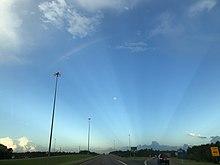

Anticrepuscular rays, or antisolar rays,[1] are meteorological optical phenomena similar to crepuscular rays, but appear opposite of the Sun in the sky. Anticrepuscular rays are essentially parallel, but appear to converge toward the antisolar point, the vanishing point, due to a visual illusion from linear perspective.[2][3]
Anticrepuscular rays are most frequently visible around sunrise or sunset. This is because the atmospheric light scattering that makes them visible (backscattering) is larger for low angles to the horizon than most other angles. Anticrepuscular rays are dimmer than crepuscular rays because backscattering is less than forward scattering.
Anticrepuscular rays can be continuous with crepuscular rays, curving across the whole sky in great circles.[4]
Mountain shadow
A common example of a single anticrepuscular ray is provided by the shadow of a mountain at sunset, when viewed from the summit. It appears to be triangular, whatever the shape of the mountain, with the apex at the antisolar point.[4]
Wagon-wheel spokes
Anticrepuscular rays are sometimes seen enclosed by a rainbow. In this case they can be called wagon-wheel spokes.[4]
References
- ^ Cowley, Les, "Anti-solar (anti-crepuscular) rays", Atmospheric Optics, retrieved March 19, 2015
- ^ John A. Day (2005), The Book of Clouds, Sterling Publishing Company, Inc., pp. 124–127, ISBN 978-1-4027-2813-6
- ^ Cowley, Les, "Antisolar rays", Atmospheric Optics, retrieved March 19, 2015
- ^ a b c Lynch, D. K., & Livingston, W. (1995). Color and light in nature. Cambridge: Cambridge University Press.
External links
 Media related to Anticrepuscular rays at Wikimedia Commons
Media related to Anticrepuscular rays at Wikimedia Commons- Atmospheric optics: anticrepuscular rays
- Images of anticrepuscular rays at Astronomy Picture of the Day site (copyrighted images):


_rays.jpg)

